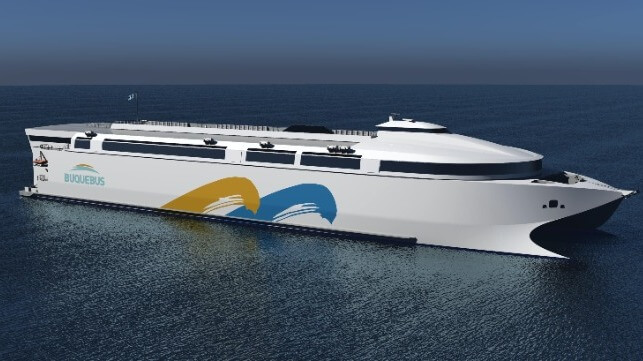New Battery-Electric Ferry Smashes Records

Uruguayan operator Buquebus is set to become the owner of the first battery-electric ferry in South America, and it will be a record-holder. This lightweight aluminum-hulled ro/pax will have the largest energy storage battery ever installed on a vessel of any kind. At 40 MWh, it will have four times the capacity of the next-biggest installation, and 40 times the power of the world's first battery-powered car ferry, the Ampere. It will also have the longest route of any battery-powered vessel, at the highest speed, and it will refuel with the world’s most powerful shore charging systems.
The massive battery enables a boundary-stretching application of all-electric power. This 425-foot vessel will make the 145-nautical mile crossing between the ports of Buenos Aires and Montevideo, across the Rio de la Plata. It is no small harbor ferry: this vessel will have enough space aboard for 2,100 passengers and crew, plus 225 cars and a 6,000-square-foot duty-free store.
Buquebus has a record of pushing the envelope with high-tech projects. Its flagship vessel, the Francisco, uses LNG-fueled gas turbine engines to reach a top speed of about 55 knots, making it the fastest passenger vessel in the world. When it decided to pursue a battery-electric vessel for its next project, it worked with Francisco's builder - Incat - to explore options. In partnership with battery-builder Corvus and marine technology provider Wärtsilä, Incat designed an aluminum fast-ferry that breaks through the boundaries of all-electric power's potential.
The battery bank design, according to the partners, is what made it all possible. Corvus stripped the mounting rack out of the design concept, reducing weight and making it more compact (while still complying with all safety requirements). The reduced battery-bank weight - combined with aluminum construction - enables a shallow-draft design that can operate in the limited water depth of the Rio de la Plata.
"It is all possible because we have now developed a new battery that is extremely light in weight and also extremely good on volume density," said Corvus commercial director Halvard Hauso.
The battery bank is a massive order for Corvus, equivalent to the firm's total production in its first eight years of operations, according to Hauso. The new design also opens up new horizons for battery-electric power, and in five years, he says, this ferry might not even be considered a big project. "This can open up new markets like crossing the English Channel with zero emissions," Hauso says.
The project has also attracted significant attention for Incat, and is expected to draw in additional business.
"Worldwide interest in Incat’s capabilities to deliver electric ships is a great opportunity for Tasmania and we expect this interest to magnify," said Incat founder Robert Clifford. "We are already increasing our workforce and have just finalized plans for the recruitment of at least another 200 employees over the next 12 months with the expectation that our workforce will more than double in coming years."
Wärtsilä will be providing propulsion system integration, including the batteries, the electric motors, energy management systems, shore charging systems, and eight axial-flow waterjets
No comments:
Post a Comment